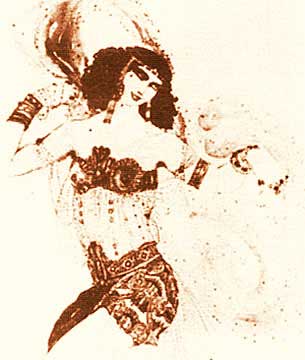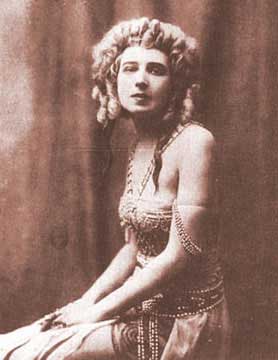
Léon Baskt's design of Ida as Salomé
Jpeg by M. Evans from scan of P.D. image

Ida Rubinstein as Salomé
Jpeg by M. Evans from scan of P.D. image*
| Ida's Early Life & Salomé 1908 |
| 1885-1908;
Lydiia Lvovna Rubinstein is raised among the extraordinarily wealthy Russian
aristocracy in St. Petersburg by relatives of her deceased parents, Lvov
and Ernestine. She always uses the name Ida. Lofty social connections
protect this particular Jewish family from the deadly anti-semitism of
the Tsarist Empire. After an inspirational trip to Greece, she arranges a meeting with theatrical designer and artist Lev Rosenberg (Léon Baskt) who helps her stage a shortened version of Antigone before a private audience, which coincidentally includes Serge Diaghilev, who later founds the Ballet Russes. She and Baskt become lifelong friends. Ida Rubinstein meets Mikhail Fokine and literally follows the choreographer to Switzerland, where he's on holiday with his wife and family, to work with him on the legendary Dance of the Seven Veils. On a subsequent trip to France, she is institutionalized by the husband of her sister Irene Lewinsohn, in order to stop her from arranging a public theatrical performance for herself in Paris. After she returns to her family in Russia, she legally marries her cousin Vladmir Horwitz, gaining control of her inheritance and social independence. |

Léon Baskt's design of Ida as Salomé Jpeg by M. Evans from scan of P.D. image |
 Ida Rubinstein as Salomé Jpeg by M. Evans from scan of P.D. image* |
|
Salomé Ida presented
her second private production in St. Petersburg after her wedding, and
an intervening journey to Syria without her new husband. Vicki Woolf
claims that her performance was fordidden by censors after the dress
rehearsal. Michael de Cossart states that it went on anyway. Toni
Bentley agrees, and gives a detailed account of the performance and
it's context. |